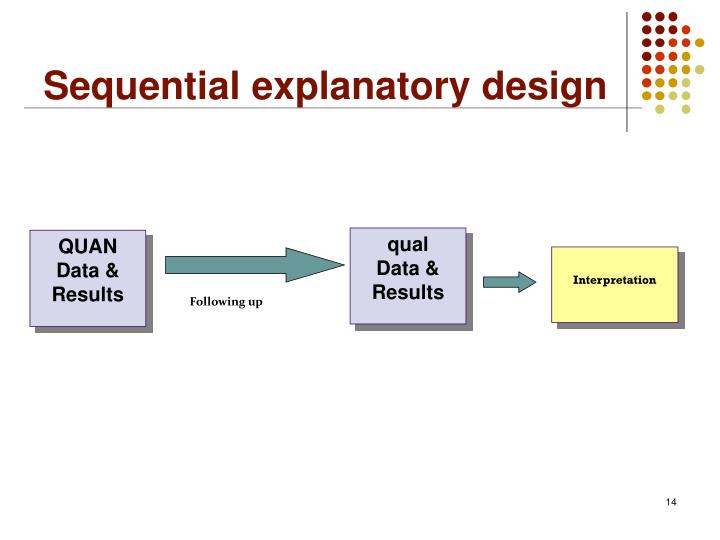Table Of Content

The three-stage sampling plan with its two interim analyses introduces somewhat greater reduction in power, but it compensates with greater reduction in expected sample size. Either interim-analysis strategy is more efficient than a single end-of-study analysis in terms of power per unit of sample size. Consequently, the social sciences dedicated to studying the complexity of organisations have been undergoing substantial changes in the use of methodologies for the generation of scientific knowledge and support for decision-making. Other studies by Fetters and Molina-Azorin [25] found that articles on mixed methods applied to the social sciences, especially in education, were more cited than those that did not use them.
2. PHASE 2: Integral Analysis of Inter-Paradigmatic Connection

In these designs, mixing occurs in an interactive manner at all stages of the study. At each stage, one approach affects the formulation of the other, and multiple types of implementation processes can occur. The question arises whether researchers should plan all these decisions beforehand, or whether they can make them during, and depending on the course of, the research process. On the one hand, a researcher should decide beforehand which research components to include in the design, such that the conclusion that will be drawn will be robust. On the other hand, developments during research execution will sometimes prompt the researcher to decide to add additional components.
A gated group sequential design for seamless Phase II/III trial with subpopulation selection - BMC Medical Research ... - BMC Medical Research Methodology
A gated group sequential design for seamless Phase II/III trial with subpopulation selection - BMC Medical Research ....
Posted: Tue, 03 Jan 2023 08:00:00 GMT [source]
Longitudinal research designs
For the acceptance of the test results, the number of values was 0 to 1, with 0 representing absolute conflict and 1 representing absolute consensus. Krippendorff [44] posits that it is typical to expect an alpha value of 0.800 as an acceptable baseline, while 0.667 can be regarded as the lower reasonable threshold (L.L.) for which preliminary assumptions are permissible. In this paper, Scott’s Pi is applied without considering the confidence interval; however, a confidence interval is supposed to demonstrate how high the achieved reliability can get. Complexity, then, not only depends on the number of components, but also on the extent to which they depend on each other (e. g., “one approach affects the formulation of the other”). (4) using a framework (theoretical or program) to bind together the data sets (Creswell and Plano Clark 2011, p. 76).
Control of Type I Error Rates in Bayesian Sequential Designs
This could be a factor in why our hypothetical research found a more optimistic picture of intelligence and aging as the years went by. At each time of testing, they could randomly recruit more participants from the same cohort as the original members, to replace those who have dropped out. Of course, the researcher’s ethical component will determine the quality of the study’s content. And because almost every science has someone who cleverly combines things, we have a sequential design, also sometimes referred to as a cross-sequential design, which is defined as a combination of longitudinal and cross-sectional designs, by following several differently aged cohorts over time.
1. PHASE 1: Qualitative Analysis (Diagnosis)
Two ways that researchers collect data can be illustrated by comparing cross-sectional vs. longitudinal studies. This reinforces the assertion by Cresswell [3] and Edmonds and Kennedy [1] of the benefits offered by this type of approach. To extract relevant assumptions, QUAN analysis involves the statistical data analysis of many sample examples, while QUAL analysis relies on chosen semi-representative cases or descriptive representations in metanalyses [23]. The data analysis of the QUAL data was based on the inferential qualitative content analysis described by Mayring [53] and followed the coding procedure described by Adu [49] in this paper. Compiling interview transcripts is a normal first step in qualitative content research, according to Erlingsson and Brysiewicz [70] and Adu [49]. The qualitative content analysis aims to organise and summarise large amounts of material [2].

Perhaps the simplest approach is to design is to look at a single book and select one from the few designs included in that book. Here we have shown that one often needs to construct a research design to fit one’s unique research situation and questions. Much more important, however, than a design name is for the author to provide an accurate description of what was done in the research study, so the reader will know exactly how the study was conducted. The overall goal of mixed methods research, of combining qualitative and quantitative research components, is to expand and strengthen a study’s conclusions and, therefore, contribute to the published literature. In all studies, the use of mixed methods should contribute to answering one’s research questions. The Sequential Predictive Research Design (DISPRE) is a techno-methodological strategy to address complex research problems in the social sciences, which envisages the necessary integration to determine qualitative and quantitative variables’ behaviour.
The authors wish to acknowledge the University of Johannesburg for the resources used to conduct this study (SPSS and AtlasTi). To ensure clarity in the keynote and the spheres of the enquiry and assessment, Arksey and Knight [35] support the idea of two interviewers; however, this view is refuted by Whiting [36], who posits that the use of a single interview conductor is sufficient. Whiting [36] substantiates this assertion by further providing robust interview guidelines.
Sequential Trigon-6 is Dave Smith's final love letter to American synth icons - MusicTech
Sequential Trigon-6 is Dave Smith's final love letter to American synth icons.
Posted: Wed, 02 Aug 2023 07:00:00 GMT [source]
Explanatory Sequential Design - Two phase design where quantitative data is collected and analyzed first, then qualitative data is collected and analyzed based on the quantitative results. Convergent Mixed Methods Design - One phase design where both quantitative and qualitative data collected and analyzed, then compared the analysis of quantitative and qualitative data to see if the data confirms or disconfirms each other. The idea of group sequential designs obviously is to come up with bounds that lead to overall 5% type I error.
5. Survey Data Collection Procedure
Hypothesis testing is the last step in the model analysis, and it is performed as a critical step to test if the defined and refined study hypothesis still holds or should be rejected. A generalised, structured component analysis model, such as the non-parametric model, may be used to meet model fit requirements, according to Cho et al. [71]. While model fit refers to how well a model fits the data, rather than how well the model’s variables correlate, reliability relates to how well a model matches the data. Since each model fit must statistically fulfil specific criteria before being labelled a data fit, the criterion must be defined before data collection [71]. Louangrath [67] proposed a set of interconnected tests for determining reliability in non-parametric data, including raw reliability estimates, Monte Carlo simulation and N.K.
As a result of the survey, a quantifiable framework for assessing senior leadership commitment to H&S in construction work was established to help with future research. The primary design dimensions explained above have been the focus of this article. There are a number of secondary considerations for researchers to also think about when they design their studies (Johnson and Christensen 2017). Now we list some secondary design issues and questions that should be thoughtfully considered during the construction of a strong mixed methods research design. Teddlie and Tashakkori’s (2009) multilevel mixed designs and fully integrated mixed designs are both complex designs, but for different reasons. A multilevel mixed design is more complex ontologically, because it involves multiple levels of reality.
Many bodies recommend that a sample planning procedure, such as traditional NHST a priori power analysis, is conducted during the planning stages of a study. Power analysis allows the researcher to estimate how many participants are required in order to detect a minimally meaningful effect size at a specific level of power and Type I error rate. In this study, we explore how these three theoretical issues are reflected in applied psychological research in order to better understand whether these issues are concerns in practice. To investigate how power analysis is currently used, this study reviewed the reporting of 443 power analyses in high impact psychology journals in 2016 and 2017.
Addition of a component of the other type can sometimes remedy such an inadequacy. Unexpected outcomes are by definition not foreseen, and therefore cannot be included in the design in advance. Some authors state that design typologies are particularly useful for beginning researchers and interactive approaches are suited for experienced researchers (Creswell and Plano Clark 2011). However, like an experienced researcher, a research novice needs to align the components of his or her design properly with each other, and, like a beginning researcher, an advanced researcher should indicate how qualitative and quantitative components are combined with each other.
Simultaneity indicates whether data collection is done concurrent or sequentially. Dependence indicates whether the implementation of one component depends upon the results of data analysis of the other component. As we will see in the example case studies, a concurrent design could include dependent data analysis, and a sequential design could include independent data analysis.

No comments:
Post a Comment